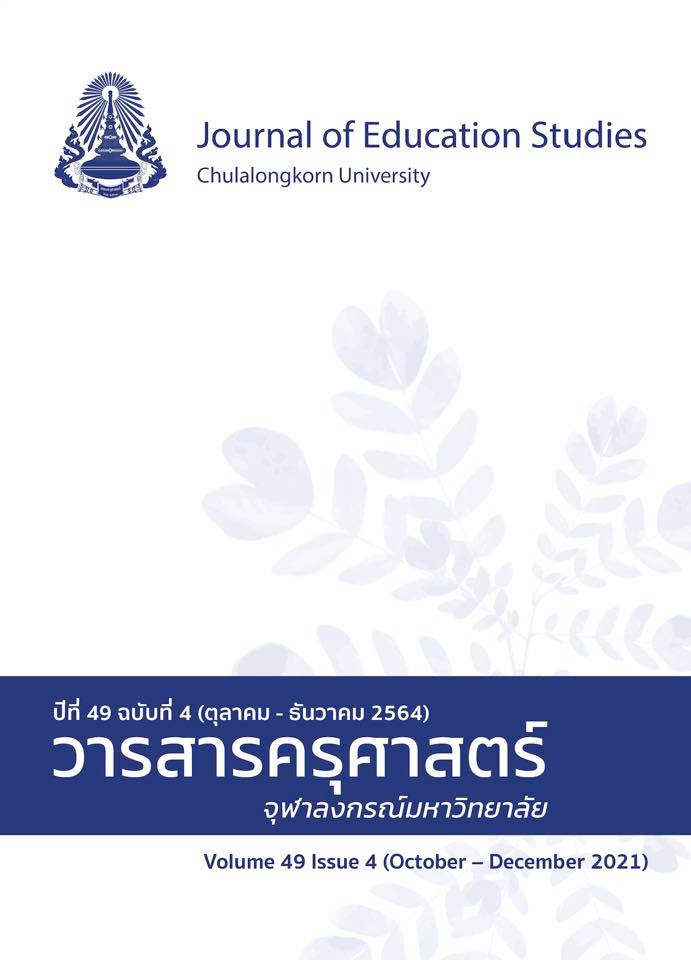The Development of Conceptual Transferability of Grade 8 Student in the Topic of Solutions Using Context - Based Learning
DOI:
https://doi.org/10.14456/educu.2021.77Keywords:
context-based learning, conceptual transferability, solutionsAbstract
The purposes of this classroom action research were to: 1)develop students’ conceptual transferability about solutions using context-based learning and 2)find the best practice to develop conceptual transferability in the topic of solutions using context-based learning. The research participants were 30 grade 8students in a girl’s school of the Secondary Educational Service Area Office, Nonthaburi. The data were collected from 1) conceptual transferability test, 2) teacher’s journal, 3) advisor’s supervision journal, and 4) student’s semi-structured interview. The data were analyzed using descriptive statistics and content analysis. The results showed that the students had conceptual transferability for each component at a variety of levels. The component of understanding the concept and deciding to apply the concept was developed to a good level, but the component which required the students to link concept in a new situation was developed to a fair level. The study showed that the best practices to develop conceptual transferability in the topic of solutions using context-based learning were: 1) integrating misconceptions into the situation on setting focal event step for promoting students’ suspicion and leading them to investigate further; 2) Using an online laboratory accompanied with probing questions to promote understanding of
a scientific concept, and link the knowledge to other similar situations; 3) Teaching sequentially from the concrete concepts to abstract concepts; 4)Using daily situations accompanied by storytelling to encourage the students to apply their knowledge further in similar situations using the reasoning developed from learned concepts.
References
ชรินดา สุขแสนชนานันท์. (2557). การพัฒนาแนวคิดและความสามารถในการถ่ายโอนแนวคิดเรื่องพลังงานความร้อนของ
นักเรียนชั้นมัธยมศึกษาตอนต้น โดยการจัดการเรียนรู้แบบอิงบริบท [วิทยานิพนธ์ปริญญามหาบัณฑิต,
มหาวิทยาลัยเกษตรศาสตร์]. http://www.lib.ku.ac.th.portal.lib.ku.ac.th/KUthesis/2555/charinda-
suk/index.html
ธีรพงศ์ แก่นอินทร์. (2554). วิธีสอนแบบโสเครติส. วารสารศึกษาศาสตร์ มหาวิทยาลัยสงขลานครินทร์ วิทยาเขตปัตตานี,
22(2), 158-166.
พลอยนัดดา ผาบไชย, สุรีย์พร สว่างเมฆ, และ อนุสรณ์ วรสิงฆ์. (2563). การพัฒนาการรู้วิทยาศาสตร์ เรื่อง กรด-เบส
ด้วยการจัดการเรียนรู้ที่ใช้บริบทเป็นฐาน สำหรับนักเรียนชั้นมัธยมศึกษาปีที่ 5. วารสารศึกษาศาสตร์
มหาวิทยาลัยนเรศวร, 22(3), 164-176.
ภัทรชา สุขสบาย. (2558). ความสามารถในการนำความรู้เรื่อง ของไหลไปประยุกต์ใช้ในชีวิตประจำวันและเจตคติต่อการเรียน
วิชาฟิสิกส์ของนักเรียนชั้นมัธยมศึกษาปีที่ 5 โดยการจัดการเรียนรู้โดยใช้บริบทเป็นฐาน [วิทยานิพนธ์ปริญญา
มหาบัณฑิต, มหาวิทยาลัยเกษตรศาสตร์]. http://www.lib.ku.ac.th.portal.lib.ku.ac.th/KUthesis/
0error/2555/patcha-soo-all.pdf
ราชศักดิ์ สว่างแวว. (2559). การพัฒนาแนวคิดเรื่อง อัตราการเกิดปฏิกิริยาเคมีของนักเรียนชั้นมัธยมศึกษาปีที่ 5
โดยการจัดการเรียนรู้แบบอิงบริบท [วิทยานิพนธ์ปริญญามหาบัณฑิต, มหาวิทยาลัยเทคโนโลยีพระจอมเกล้าธนบุรี].
http://digital.lib.kmutt.ac.th/thesis/loadfile.php?obj_id=36997
ศิรินทร บุญสู. (2546). ผลของการใช้ชุดฝึกการแก้ปัญหาโจทย์คำนวณที่เน้นเทคนิคแผนผังทางปัญญาที่มีต่อผลสัมฤทธิ์
ทางการเรียนวิชาเคมีของนักเรียนชั้นมัธยมศึกษาปีที่ 4 [วิทยานิพนธ์วิปริญญามหาบัณฑิต, สถาบันเทคโนโลยี
พระจอมเกล้าเจ้าคุณทหารลาดกระบัง]. https://opacimages.lib.kmitl.ac.th/medias/pdf/09025125.pdf
ศุภกร สุขยิ่ง, ธิติยา บงกชเพชร, และ นุชจิรา ดีแจ้ง. (2560). การจัดการเรียนรู้แบบใช้บริบทเป็นฐานร่วมกับการใช้ข่าวเป็นสื่อ
เรื่องสภาพสมดุลเพื่อพัฒนาการรู้เรื่องวิทยาศาสตร์ของนักเรียนชั้นมัธยมศึกษาปีที่ 4. วารสารวิชาการศึกษาศาสตร์,
18(2), 31-44.
เอกภูมิ จันทรขันตี. (2554). เอกสารประกอบการสอนรายวิชา 01159222 วิธีการสอนวิทยาศาสตร์และเทคโนโลยีในระดับ
มัธยมศึกษา [เอกสารที่ไม่ได้ตีพิมพ์]. ภาควิชาการศึกษา คณะศึกษาศาสตร์, มหาวิทยาลัยเกษตรศาสตร์.
ภาษาอังกฤษ
Calik, M., & Ayas, A. (2005). A cross-age study on the understanding of chemical solutions and their
components. International Education Journal, 6(1), 30-41.
Gilbert, J. K. (2006). On the nature of “context” in chemical education. International Journal of Science
Education, 28(9), 957-976.
Johnstone, A. H. (2000). Chemical education research: Where from here? Proceedings from variety in
chemistry teaching meeting. University Chemistry Education, 4(1), 34-38.
John, K. G., Astrid, M. W. B., & Albert, P. (2011). Concept development and transfer in context-based science
education. International Journal of Science Education, 33(6), 817-837. http://doi.org/10.1080/
09500693.2010.493185
Kemmis, S., McTaggart, R., & Nixon, R. (2014). The action research planner: Doing critical participatory action
research. Springer.
The Organization for Economic Co-operation and Development (OECD). (2016). PISA 2015 results
(Volume I): Excellence and equity in education. OECD publishing.
Downloads
Published
How to Cite
Issue
Section
License

This work is licensed under a Creative Commons Attribution-NonCommercial-NoDerivatives 4.0 International License.




